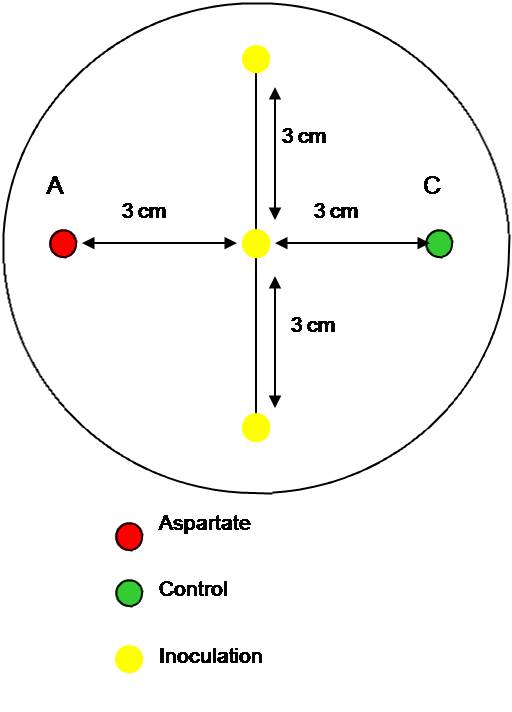Team:BCCS-Bristol/Calendar-Notebook/9 July 2008
From 2008.igem.org
Tgorochowski (Talk | contribs) |
JGSchenkel (Talk | contribs) (→Swimming agar assay with aspartic acid) |
||
| Line 19: | Line 19: | ||
We conducted a second swimming agar assay with ''E. coli'' MG1655. This time, we added paper discs that were soaked with a L-aspartic acid solution. We wanted to observe whether the bacteria are attracted by the amino acid. We tested again different parameters: | We conducted a second swimming agar assay with ''E. coli'' MG1655. This time, we added paper discs that were soaked with a L-aspartic acid solution. We wanted to observe whether the bacteria are attracted by the amino acid. We tested again different parameters: | ||
| - | + | *agar concentrations of 0.15 %, 0.3 % and 0.5 % | |
| - | + | *incubation temperatures of 25 <sup>o</sup>C, 30 <sup>o</sup>C and 37 <sup>o</sup>C | |
| - | + | *inoculations depths of "on the surface", "under the surface" and "deep in the medium" | |
| - | + | *aspartic acid concentrations of 0.2 %, 0.1 % and 0.01 % | |
Photos of swiming agar were taken and travelled distances measured. 0.3% agar was found to be the best for an overnight culture and a temperature of 37<sup>o</sup>C was too high, since the swarms spread over the whole plate. All plates showed swarm spread at different levels giving inner and outer rings. Unfortunately, we observed no different movement/growth towards the L-aspartic acid compared with the control (water). It was assumed that this is due to the low concentration, but it wasn't possible to made a 0.4 % solution. | Photos of swiming agar were taken and travelled distances measured. 0.3% agar was found to be the best for an overnight culture and a temperature of 37<sup>o</sup>C was too high, since the swarms spread over the whole plate. All plates showed swarm spread at different levels giving inner and outer rings. Unfortunately, we observed no different movement/growth towards the L-aspartic acid compared with the control (water). It was assumed that this is due to the low concentration, but it wasn't possible to made a 0.4 % solution. | ||
Latest revision as of 11:39, 23 September 2008
Swimming agar assay with aspartic acid
We conducted a second swimming agar assay with E. coli MG1655. This time, we added paper discs that were soaked with a L-aspartic acid solution. We wanted to observe whether the bacteria are attracted by the amino acid. We tested again different parameters:
- agar concentrations of 0.15 %, 0.3 % and 0.5 %
- incubation temperatures of 25 oC, 30 oC and 37 oC
- inoculations depths of "on the surface", "under the surface" and "deep in the medium"
- aspartic acid concentrations of 0.2 %, 0.1 % and 0.01 %
Photos of swiming agar were taken and travelled distances measured. 0.3% agar was found to be the best for an overnight culture and a temperature of 37oC was too high, since the swarms spread over the whole plate. All plates showed swarm spread at different levels giving inner and outer rings. Unfortunately, we observed no different movement/growth towards the L-aspartic acid compared with the control (water). It was assumed that this is due to the low concentration, but it wasn't possible to made a 0.4 % solution.
 "
"
